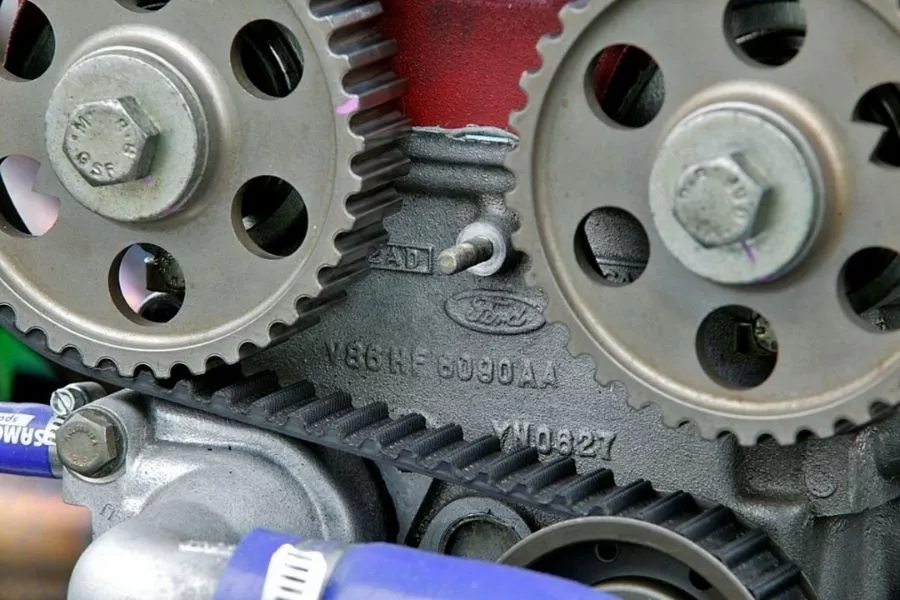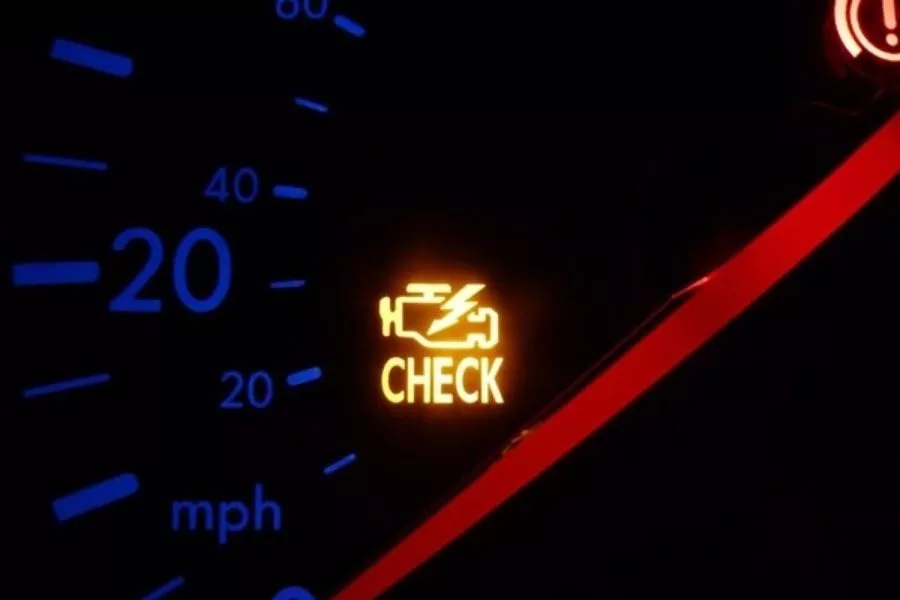Now, we’ve written about timing belts before. For those who are unaware, however, this part is an elongated closed loop made out of rubber that’s responsible for keeping the crankshaft’s rotation in-sync with the camshaft. As such, it plays a key role in making sure that the valves open and close at the right time during an engine’s exhaust and intake strokes.

A Ford Cosworth's timing belt
Timing belts vs Timing chains: What are the differences?
The timing belt shares the same functions as the timing chain. The only difference between these two is that belts are usually made out of rubber, and chains are made out of metal links hence its name. To this end, chains are less likely to snap. In some instances, they will last for thousands of kilometers before requiring any sort of repair.
Regardless, both timing belts and timing chains can break down. So, what are the symptoms of a broken timing belt?
Symptoms of broken or deteriorating timing belt
These are the signs that your timing belt is failing, or has failed. Note that a broken timing belt and a broken timing chain will produce the same failure symptoms since they function the same way.
Strange Noises – One early sign of a failing timing belt/chain is a ticking noise coming from the engine bay. Do note though that this can also be a sign of low oil pressure. In the case of timing belts, the ticking noise can result from non-synchronized or poorly synchronized internal engine parts.
Engine won’t start – A completely broken timing belt will prevent you from starting your engine. If you try to start it, you’ll hear your starter motor and even your fuel pump come to life. The engine, however, will not turn over at all.
![A timing belt that snapped. [Photo: Miataforums] A picture of a timing belt that snapped](https://img.philkotse.com/temp/2024/07/27/snapped-timing-belt-miataforums-15ee-2e76.webp)
A timing belt that snapped. [Photo: Miataforums]
In turn, a catastrophic timing belt failure (a snap), will likely occur while you’re already driving. In this case, your car’s internal parts might have suffered as a consequence. The most common problems caused by a timing belt snapping while the engine was running are bent valves, camshaft damage, and cylinder head damage.
Engine misfiring – As we’ve said, the timing belt/chain is responsible for keeping the camshaft and crank operating in-sync. If the timing belt/chain fails, you can expect engine misfires. If you aren’t aware of what an engine misfiring is, it usually comes in the form of popping sounds. Misfiring can also be detected by the smell of gas, inconsistent power delivery, and vibrations.
Car check engine light is on – In many modern cars, a bad timing belt or chain will also result in the check engine pilot light coming on.

A bad timing belt or timing belt failure can also cause the check engine light to turn on
When to replace the timing belt?
As mentioned above, snapping a timing belt while driving is scary. As such, some of you might want to be proactive in maintaining the said part.
According to most manufacturer standards, a timing belt should be replaced every 70,000 to 90,000 km. That figure can depend on the make and model of the car, but that odometer range we’ve mentioned is a good estimate to remember. In addition, timing chains also need regular checks too. But since they’re more robust, they can last longer. At the least, a timing belt should be replaced at around 120,000 km barring significant problems.
![Engine damage caused by timing belt failure [Photo: Reddit u/whatudrivin] Internal engine damage caused by timing belt failure](https://img.philkotse.com/temp/2024/07/27/engine-damage-1284-a337.webp)
Engine damage caused by timing belt failure [Photo: Reddit u/whatudrivin]
Of note, the price of a replacement timing belt will also depend on the car. A replacement timing belt for a 2013-2015 Toyota Vios for example can cost somewhere between Php 600 to Php 800. A timing belt for the Toyota Innova, Fortuner, and Hilux 2005-2015 on the other hand, starts at around Php 1,600 and above.
Inspecting a timing belt
As good practice, we recommend checking your timing belt once in a while. Things to watch out for are worn down belt teeth, cracks on the belt itself, a wet belt (usually oil), worn timing belt edges, and sheared off belt teeth. Once you spot any of these, replace your timing belt immediately.
For more car maintenance guides, keep it here on Philkotse.com.
Broken Timing Belt: FAQ
1. Why don’t all cars use timing chains if these are more durable?
Answer: Not all cars come with timing chains because of manufacturing costs. Acquiring and shaping rubber into a belt is much cheaper and making steel chain links.
2. What causes a timing belt to deteriorate prematurely?
Answer: There are many causes for premature deterioration in timing belts. The most common are incorrect tension, work-out idlers, the engine is too hot, oil leaks, among others.
3. What is a timing belt made of?
Answer: A typical timing belt is made by combining rubber and a high-tensile fiber.
4. How do I know if my engine timing is bad?
Answer: Common signs of bad engine timing are odd noises, check engine light, hard start, rough idle, or loss of power.
5. Can I still drive a car with a bad timing belt?
Answer: Yes, you can drive a car with a bad timing belt but we do not recommend doing so. Be aware that a deteriorated belt might snap off at any moment while operating the car. If this happens, it may result in even more engine damage.
Recent posts
- difference between drive belt vs timing belt Aug 18, 2023
- 7 simple steps to have timing chain replaced by yourself Aug 16, 2022
- 5 Signs of a Failing Timing Chain that every driver should know Aug 16, 2022
- How does a timing belt in your car engine work? Feb 19, 2021












